Factoring semi-primes with the resonator network#
from pylab import *
import math
import res_utils as ru
%matplotlib inline
plt.rcParams.update({'font.size': 18})
plt.rcParams.update({'font.family': 'serif',
'font.serif':['Computer Modern']})
# return a dict or a list of primes up to N
# create full prime sieve for N=10^6 in 1 sec
def prime_sieve(n, output={}):
nroot = int(math.sqrt(n))
sieve = np.arange(n+1)
sieve[1] = 0
for i in range(2, nroot+1):
if sieve[i] != 0:
m = int(n/i - i)
sieve[i*i: n+1:i] = [0] * (m+1)
if type(output) == dict:
pmap = {}
for x in sieve:
if x != 0:
pmap[x] = True
return pmap
elif type(output) == list:
return [x for x in sieve if x != 0]
else:
return None
prime_range = int(1e4)
list_of_primes = prime_sieve(prime_range, [])
prime_approx_x = np.linspace(0, prime_range, 500)
plot(prime_approx_x/(np.log(prime_approx_x)-1), prime_approx_x, ":k")
plot(list_of_primes)
/var/folders/xn/hqbqng2d6nz8f1lcyd545kqr0000gn/T/ipykernel_13105/543448723.py:3: RuntimeWarning: divide by zero encountered in log
plot(prime_approx_x/(np.log(prime_approx_x)-1), prime_approx_x, ":k")
[<matplotlib.lines.Line2D at 0x1279733d0>]
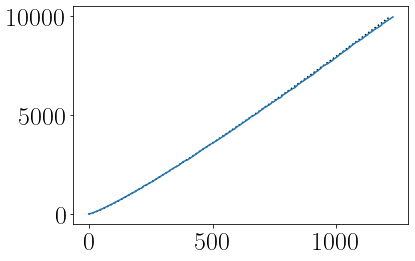
log_diff = np.diff(np.log(list_of_primes))
plot(log_diff)
[<matplotlib.lines.Line2D at 0x127a69df0>]
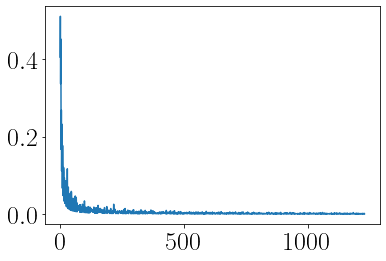
beta = 1e4/min(log_diff)
print(beta)
49649999.832372874
N = 10000
D = len(list_of_primes)
z_phi = ru.cvec(N, 1)
phi = ru.cvec(N, D)
for i in range(D):
phi[i] = z_phi ** (beta * np.log(list_of_primes[i]))
list_of_primes[0], list_of_primes[2]
(2, 5)
z10 = z_phi ** (beta * np.log(10))
z2x5 = phi[0] * phi[2]
print(np.real(np.dot(z10, np.conj(z2x5))/N))
1.0000000003400662
res_vecs = [phi, phi]
pidx1 = np.random.randint(len(list_of_primes))
pidx2 = np.random.randint(len(list_of_primes))
# make smaller number index 1
if pidx1 > pidx2:
pidx1, pidx2 = pidx2, pidx1
p1 = list_of_primes[pidx1]
p2 = list_of_primes[pidx2]
s = p1 * p2
print(p1, p2, s)
6113 9631 58874303
bound_vec = z_phi ** (beta * np.log(s))
tst = time.time()
res_hist, nsteps = ru.res_decode_abs_slow(bound_vec, res_vecs, 200)
print('Elapsed:', time.time() - tst)
converged: 26
Elapsed: 3.2865653038024902
# visualize the convergence dynamics
figure(figsize=(8,3))
ru.resplot_im(res_hist, nsteps)
plt.tight_layout()
[796, 1189]
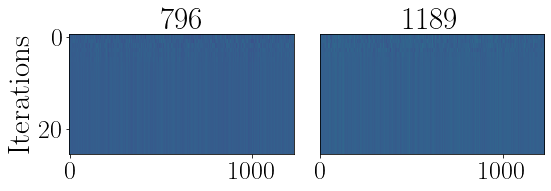
#res_hist2 = [res_hist[0][:, 100*(p1//100):(100*(p1//100)+100)], res_hist[1][:, 100*(p2//100):(100*(p2//100)+100)]]
p1st = 100*(pidx1//100)
p2st = 100*(pidx2//100)
res_hist2 = [res_hist[0][:, p1st:(p1st+100)], res_hist[1][:, p2st:(p2st+100)]]
print(p1st, p2st)
700 1100
# visualize the convergence dynamics
figure(figsize=(8,3))
ru.resplot_im(res_hist2, nsteps)
plt.tight_layout()
[96, 89]
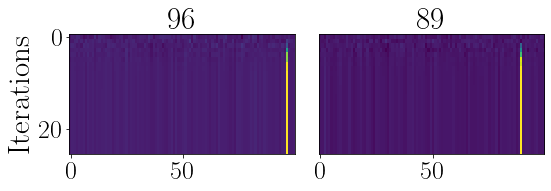
out_w, out_c = ru.get_output_conv(res_hist, nsteps)
print(out_w, out_c)
[796, 1189] 1
print(list_of_primes[out_w[0]], list_of_primes[out_w[1]])
print(p1, p2)
6113 9631
6113 9631
limiting number of factors#
sqrt_cutoff = np.where(list_of_primes <= np.sqrt(s))[0][-1]
shalf_cutoff = np.where(list_of_primes <= s/2)[0][-1]
phi_low = phi[:sqrt_cutoff+1]
phi_high= phi[sqrt_cutoff:shalf_cutoff]
print(sqrt_cutoff, shalf_cutoff)
971 1228
phi_low.shape, phi_high.shape
((972, 10000), (257, 10000))
res_vecs2 = [phi_low, phi_high]
tst = time.time()
res_hist, nsteps = ru.res_decode_abs_slow(bound_vec, res_vecs2, 200)
print('Elapsed:', time.time() - tst)
converged: 12
Elapsed: 0.790489912033081
# visualize the convergence dynamics
figure(figsize=(8,3))
ru.resplot_im(res_hist, nsteps)
plt.tight_layout()
[796, 218]
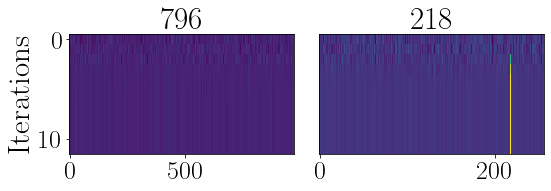
#res_hist2 = [res_hist[0][:, 100*(p1//100):(100*(p1//100)+100)], res_hist[1][:, 100*(p2//100):(100*(p2//100)+100)]]
p1st = 100*(pidx1//100)
p2st = 100*((pidx2-sqrt_cutoff)//100)
res_hist2 = [res_hist[0][:, p1st:(p1st+100)], res_hist[1][:, p2st:(p2st+100)]]
print(p1st, p2st)
700 200
# visualize the convergence dynamics
figure(figsize=(8,3))
ru.resplot_im(res_hist2, nsteps)
plt.tight_layout()
[96, 18]
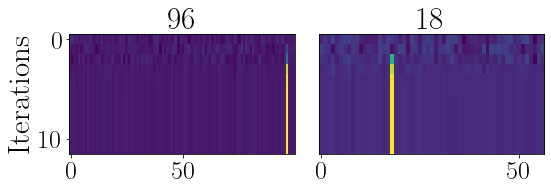
out_w, out_c = ru.get_output_conv(res_hist, nsteps)
print(out_w, out_c)
[796, 218] 1
out_w[1] += sqrt_cutoff
print(list_of_primes[out_w[0]], list_of_primes[out_w[1]])
print(p1, p2)
6113 9631
6113 9631
